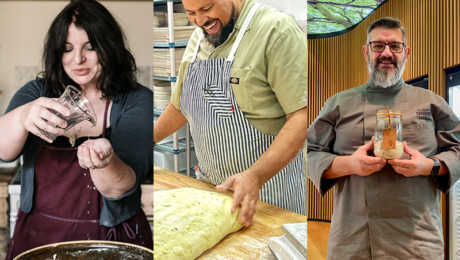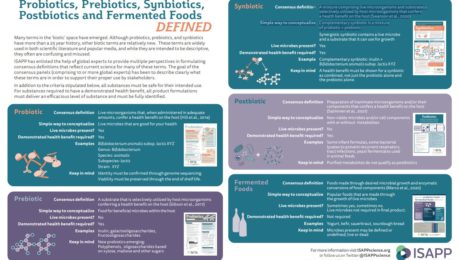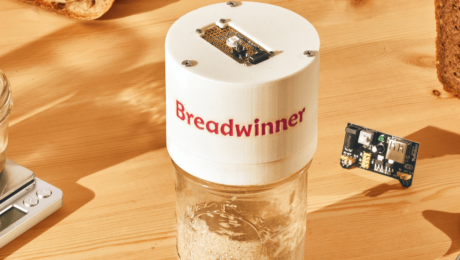Sourdough Fermentation & Gut Health
Sourdough is being researched for its effectiveness in helping people with celiac disease and gluten sensitivities. Charlene Van Buiten, PhD, an assistant professor of food science and human nutrition at Colorado State University, shared how sourdough can alleviate problems with gut health in an article she wrote for Baking Europe.
The live, active cultures contained in fermented foods like kimchi, pickles, kombucha and yogurt have been scientifically proven to increase the diversity of microorganisms in the digestive tract. A recent study from researchers at Stanford found a diet rich in fermented foods decreases markers of inflammation.
The same health benefits cannot be attributed to sourdough, though, because the live microorganisms are killed during baking.
“As a result, the health benefits associated with sourdough bread are derived not from probiotics, but from the actions of the starter culture over the course of fermentation,” Van Buiten writes. The microorganisms present in starter cultures “have been shown to improve mineral bioavailability in sourdough bread in comparison to conventional yeast-fermented bread through the production of organic acids and enzyme phytase, which promote the degradation of anti-nutritional phytates found naturally in flour. “
Sourdough bread has other positive effects, too. The increased acidity of sourdough forms resistant starch, so starch is not converted to sugar by the gastrointestinal tract but instead “acts more like fiber.” Sourdough fermentation also increases the amount of free amino acids in bread, improving the protein digestibility. Sourdough bread made from starter cultures are also lower on the glycemic index.
Van Buiten points out case studies “have suggested that traditional sourdough fermentation can improve gastrointestinal tolerance to bread in comparison to conventional yeast fermentation,” but only for individuals with non-celiac gluten sensitivity. Few studies have explored how sourdough would impact someone with celiac. A study would need to explore gluten degradation within sourdough fermentation, a key sensitivity for individuals with celiac.
“Though no evidence currently exists where traditional artisanal sourdough fermentation provides protection against the harmful gluten peptides associated with celiac disease pathogenesis, scientists are exploring novel strategies to employ the known gluten-degrading capabilities of sourdough-derived microorganisms in the production of baked goods,” Van Buiten adds.
Read more (Baking Europe)
Better Bread: Study Proves Sourdough Wins
Plenty of anecdotal evidence lauds sourdough as the healthier bread alternative for those with wheat or gluten intolerance, but there is little research providing data on the topic. Now new research proves the longer a sourdough ferments, the better the bread.
Sourdough is a fermented bread fortified with dietary fibers, increased mineral bioavailability, lower glycemic index and improved protein digestibility compared to its unfermented counterparts. And, as more people shun traditional bread because of a wheat or gluten intolerance, sourdough is increasing in popularity.
Researchers at the University of Minnesota are studying the effects of dough fermentation and wheat varieties to create a bread that’s easier to digest. They found the longer fermentation time makes a more digestible bread. The results, published in November in the Journal of Cereal Science, found a 12 hour ferment versus a four hour ferment dramatically reduces the short-chain carbohydrates that aren’t absorbed properly in the gut.
“Wheat sensitivity seems to be getting worse,” says James Anderson (pictured, left), professor and wheat breeder at the University of Minnesota and one of the study authors. “The motivation for me as a wheat breeder to get involved in this research is the wheat sensitivity issue.”
Those short-chain carbs – FODMAPs (fermentable oligosaccharides, disaccharides, monosaccharides and polyols) and ATIs (amylase/trypsin-inhibitors) – are what causes digestive problems in some people.
“There is evidence to document that sourdough processing or fermentation in general is able to reduce these FODMAPs and ATIs,” said George Annor (pictured, right), a professor of cereal chemistry and technology at the University of Minnesota and another of the study’s authors.
While fermentation time makes a difference in digestibility of sourdough, so do wheat varieties. Ancient grains such as Einkorn and Emmer performed well, same with the modern Linkert variety.
Though the study proves sourdough and other slow-rising breads can help those who are sensitive to wheat, the modern baking industry is dominated by sped up processing techniques. Like most commercial breads, frozen pizza crust and other convenience foods. Annor says he wants “them to keep those processes as much as they can,” but using a better wheat variety will aid digestibility.
“There’s more that we don’t know about fermentation than we do know, and it’s a wonderfully complex world,” says Brian LaPlante, a fellow Minnesotan and owner of Back When Foods.
LaPlante and his wife began making their own sourdough with ancient grains from his brother’s farm when LaPlante’s son began experiencing digestive problems. By incorporating sourdough and other fermented foods into his diet, his son’s health dramatically improved. LaPlante started his business Back When Foods that develops slow food with less processing – and hooked up with Anderson and Annor to help with their research. LaPlante provided the dough samples of varying ferment times that the UofM analyzed for their study.
“When you have fermented food in your diet, it has a profound impact on your microbiome,” he adds. “And I think that will be the trend, is food will become your medicine again.”
Chicago: A Fermentation Hub
If you still think of hot dogs and deep dish pizza as the icons of Chicago’s culinary scene, you need to think again. The so-called Capital of the Midwest is a hub of innovation in the food industry. Chicago has the largest food and beverage production in the U.S., with an annual output of $9.4 billion. Food startup companies in the region raised $723 million in venture capital last year.
“Chicago is one of the most diverse cities for eating,” says Anna Desai, Chicago-based influencer of Would You Like Something to Eat on Instagram. ”Our culinary scene is constantly elevating and evolving. We are always just a neighborhood or tollway away from experiencing a new culture and cuisine. I’m most excited when I find an under-the-radar spot or discover a maker who can pair flavors and ingredients that get you curious and wanting more.”
Desai started her blog in part because she wanted to champion the Asian American and Pacific Islanders (AAPI) community in the Chicago food and beverage scene. “Food has long served as a cultural crossroad,” she adds, and Chicago’s multicultural cuisine exemplifies that sentiment.
Chicago is home to some of the most creative minds in fermentation, from celebrity chefs, zero waste ventures, alternative protein corporations and the world’s largest commercial kefir producer. There are dozens of regional and artisanal producers lacto-fermenting vegetables, brewing kombucha and experimenting with microbes in food and drink.
“Chicago is a great food city in its own right, so naturally there is a ton of talent in the fermentation space,” says Sam Smithson, chef and culinary director of CultureBox, a Chicago-based fermentation subscription box. “The pandemic’s effect on restaurants has also spawned a new wave of fermenters (ourselves included) that are looking for a path outside the grueling and uncertain restaurant structure to display our creative efforts. This new wave is undoubtedly community-motivated and concerned more with mutual aid than competition. There is a general feeling that we are all working towards the same goal so cooperation and collaboration is soaring and we are seeing incredible food come from that.”
Flavor is King
Flavor development is still the prime motivation for chefs to experiment with fermentation. A good example is at Heritage Restaurant and Caviar Bar in Chicago’s Humboldt Park neighborhood.
“Fermentation has been a cornerstone of the restaurant since its inception,” says Tiffany Meikle, co-owner of Heritage with her husband, Guy. “With the diverse cuisines we pull from, both from Eastern and Central Europe and East Asia, we researched fermentation methodologies and histories, and started to ‘connect the dots’ of each culture’s fermentation and pickling backgrounds.”
Menus have included sourdough dark Russian rye bread, toasted caraway sauerkraut, kimchi made from apples, Korean pears and beets and a kimchi using pickled ramps (wild onions). Heritage has also expanded their fermentation program to the bar, where they’ve created homemade kombucha, roasted pineapple tepache, sweet pickled fruits for cocktail garnishes, and kimchi-infused bloody mary mix.
“It’s fascinating to me that there are so many ingredients you can use in a fermented product,” says Claire Ridge, co-founder of Luna Bay Booch, a Chicago-based alcoholic kombucha producer. “People are really experimenting with interesting ingredients in kombucha…I have seen brewers do some of the wildest recipes and some recipes that are very basic.”
Innovating Food
Chicago-based Lifeway Kefir is indicative of the innovation taking place in the city. Last year the company expanded into a new space: oat-based fermentation, launching a dairy-free, cultured oat milk with live and active probiotics.
“We’ve spent so many years laying the groundwork in fermented dairy,” says Julie Smolyansky, CEO. “Now we’re experimenting and expanding to see what’s over the next horizon, though we’ll always have kefir as our first love.”
Chicago is home for two inventive fermented alternative protein startups: Nature’s Fynd and Hyfé Foods. Both companies were born out of the desire to create alt foods without damaging the environmental.
“Conscious consumerism is a trend that’s driving many people to try alternative proteins, and it’s not hard to understand why,” says Debbie Yaver, chief scientific officer at Nature’s Fynd. The company uses fermentation technology to grow Fy, a nutritional fungi protein. “Fungi as a source of protein offer a shortcut through the food chain because they don’t require the acres of land or water needed to support plant growth or animal grazing, making fungi-based protein more efficient to produce than other options.”
Alternative foods outlasting the typical trend cycle is a challenge for companies like Nature’s Fynd. When grown at scale, Fy uses 99% less land, 99% less water and emits 94% fewer greenhouse gasses than raising beef. But, to make an impact, “we need more than just vegans and vegetarians to make changes in their diets,” Yaver adds.
Waste Not
Numerous companies are using fermentation as a means to eliminate waste. Hyfé Foods, another player in the alternative protein space, repurposes sugar water from food production to create a low-carb, protein-rich flour. Fermentation turns a waste product into mycelium flour, mycelium being the root network – or hyphae (hence the company name) — of mushrooms.
“[We’re] diverting input to the landfill and reducing greenhouse gas emissions at scale,” says Michelle Ruiz, founder. “Hyfé operates at the intersection of climate and health, enabling regional production of low cost, alternative protein that reduces carbon emissions and is decoupled from agriculture.”
Symmetry Wood is another Chicago upcycler. They convert SCOBY from kombucha into a material, Pyrus, that resembles exotic wood. Founder Gabe Tavas says Pyrus has been used to produce guitar picks, jewelry and veneers. Symmetry uses the discarded SCOBY from local kombucha brand Kombuchade.
Many area restaurants and culinary brands also use fermentation to preserve food for the long Chicago winters, when local produce isn’t available. Pop-up restaurant Andare, for example, incorporates fermentation into classic Italian dishes.
“Finding ways to utilize what would otherwise be waste products inspired our initial dive into fermentation. The goal is not just to use what’s leftover, but to make it into something delicious and unique,” says Mo Scariano, Andare’s CEO. “One of our first dishes employing koji fermentation was a summer squash stuffed cappellacci served with a butter sauce made from carrot juice fermented with arborio rice koji. Living in a place with a short grow season, preservation through fermentation allowed us access throughout the year to ingredients we only have fresh for a few weeks during the summer.”
Industry Challenges
Despite growing interest and increasing sales, fermenters face some significant hurdles.
Smithson at CultureBox says he sees that consumers are open to unorthodox, less traditional ferments. Though favorites like kombucha and sauerkraut dominate the market, “their share is being encroached on by increasingly more varied and niche ferments.” But getting these products to market can be a challenge. Small-scale, culinary producers are challenged by the regulatory hoops they need to jump through to legally sell ferments – especially unusual ones a food inspector doesn’t recognize.
“The added layer of city regulations on top of state requirements, sluggish health department responses, and inflexible policy chill the potential of small producers,” Smithson says. But he highlights the recently-passed Home-to-Market Act of Illinois as positive legislation helping startup fermenters.
Consumer awareness and education are also vital. “Many longstanding and harmful misconceptions on the safety and value of fermented products still exist,” Smithson says.
Matt Lancor, founder and CEO of Kombuchade makes consumer education a core part of marketing, to align kombucha as a recovery drink.
“Most mainstream kombuchas are marketed towards the yoga/crystal/candle crowd, and I saw a major opportunity to create and market a product for the mainstream athletic community,” he says. “We’re on a mission to educate athletes and the general public about these newly discovered organs [the gut] – our second brain – and fuel the next generation of American athletes with thirst quenching, probiotic rich beverages.”
Product packaging provides much of a consumer’s education. Jack Joseph, founder and CEO of Komunity Kombucha, says simplicity is key.
“People are more conscious of their health now, more than ever before,” he says. “So now it comes down to the education of the product and creating something that is transparent and easy for the consumer to digest.”
Sebastian Vargo of Chicago-based Vargo Brother Ferments agrees.
“Oftentimes food is considered ‘safe’ due to lack of microbes and how sterile it is,” he says. “Fermentation eschews the traditional sense of what makes food ‘safe’. We need to create a set standardized guide for fermented food to follow, and change our view of living foods in general. One of the brightest spots to me is the fact that fermentation is really hitting its stride and finding its place in the modern world, and I don’t see it going anywhere but up in the near future.”
- Published in Business, Food & Flavor
Bubbling Over: Pandemic Sourdough
Homebound during the Covid-19 outbreak, budding home bakers around the globe made sourdough baking their new hobby. Hailed as the “breakout star of pandemic-era kitchens” by The New York Times, sourdough became a national fascination as more people experimented with the microbe-enabled, tangy bread.
We asked three experts to share their thoughts on the sourdough craze — educator Vanessa Kimbell (of The Sourdough School), bakery owner Azikiwee Anderson (Rize Up Bakery) and Karl De Smedt, curator of the world’s only sourdough starter library.
The question: How did the pandemic change the market for professionally-baked sourdough? Are more people making their own or are they buying from professional bakers?
Vanessa Kimbell, founder The Sourdough School
The pandemic changed the market in several ways. The first thing is, some of the large manufacturers that I’ve been talking to have been starting to appreciate and understand that people want real sourdough. And by that I mean sourdough that is genuinely long, slow fermented with wild yeast and lactic acid bacteria. They’ve also begun to appreciate the connection between bread and health. Authenticity and integrity are the two words that come to my mind when I think about how the pandemic has impacted the professional sourdough market.
There’s no question that there was an exponential increase in home bakers making sourdough during the pandemic. It’s rather beautiful. I think when we were gifted the time to make those connections, so many of us used that. Will there be sudden change in behavior? People have now gone back to work and now I’d say there’s almost been a backlash against people wanting to take up sourdough. It became almost too trendy to the point where there can be a backlash. I have noticed there was a significant drop off as life has returned to normal. But that’s only to be expected. The joy of discovering we have a little freedom as a home baker making their own bread, I’d say it’s leveling back out again to pre-pandemic numbers.
Azikiwee Anderson, founder Rize Up Bakery
I started baking like most of the world did during the pandemic. Normally we would all just go to the store and pick up whatever mediocre bread they had on hand, never thinking twice [that] it was full of preservatives and made with cheap industrial flour. Then all of sudden we had the thing that is always in short supply “TIME”! So we all tried to connect to the nostalgia of being self-sufficient since we had no real control over most things.
The sheer amount of people connecting to their food and what it is made of is what made it amazing for small new found bakers like me! The uptick in sourdough baking taught millions of people how hard it is and how good it could be. What more is there to say!
Karl De Smedt, curator The Sourdough Library, senior communication and training manager Puratos Center for Bread Flavour
Many consumers today are excited about sourdough bread. During the pandemic, many have started baking it at home and, on social media, sourdough reached a massive peak as a sign of consumer engagement. No wonder because it truly has a unique, rich taste. According to research by Puratos, 52% of today’s consumers know sourdough . Approximately 45% of consumers associate sourdough with “better taste” and nearly 30% associate sourdough with “Rustic,” “Healthier,” and “More Natural” – opening an excellent opportunity for value creation.
For professionally-baked sourdough, there are immense opportunities. The most considerable evolution we see is that it will not matter who makes the bread in the future, but how it’s made — going from fast processes in two to three hours with only baker’s yeast. Or long processes with sourdough from 12 to 48 hours. A project like the Puratos sourdough library aims to discover more about the use of sourdough in all its aspects. We are sharing knowledge, preserving, and protecting the biodiversity of sourdough and bringing back the tradition used by more than 250 generations of bakers who used sourdough as their most precious ingredient in bread baking. That’s why, at Puratos, we believe the future of bread lies in its past.
- Published in Business, Food & Flavor, Health
The Rise of Fermented Foods and -Biotics
Microbes on our bodies outnumber our human cells. Can we improve our health using microbes?
“(Humans) are minuscule compared to the genetic content of our microbiomes,” says Maria Marco, PhD, professor of food science at the University of California, Davis (and a TFA Advisory Board Member). “We now have a much better handle that microbes are good for us.”
Marco was a featured speaker at an Institute for the Advancement of Food and Nutrition Sciences (IAFNS) webinar, “What’s What?! Probiotics, Postbiotics, Prebiotics, Synbiotics and Fermented Foods.” Also speaking was Karen Scott, PhD, professor at University of Aberdeen, Scotland, and co-director of the university’s Centre for Bacteria in Health and Disease.
While probiotic-containing foods and supplements have been around for decades – or, in the case of fermented foods, tens of thousands of years – they have become more common recently . But “as the terms relevant to this space proliferate, so does confusion,” states IAFNS.
Using definitions created by the International Scientific Association for Postbiotics and Prebiotics (ISAPP), Marco and Scott presented the attributes of fermented foods, probiotics, prebiotics, synbiotics and postbiotics.
The majority of microbes in the human body are in the digestive tract, Marco notes: “We have frankly very few ways we can direct them towards what we need for sustaining our health and well being.” Humans can’t control age or genetics and have little impact over environmental factors.
What we can control, though, are the kinds of foods, beverages and supplements we consume.
Fermented Foods
It’s estimated that one third of the human diet globally is made up of fermented foods. But this is a diverse category that shares one common element: “Fermented foods are made by microbes,” Marco adds. “You can’t have a fermented food without a microbe.”
This distinction separates true fermented foods from those that look fermented but don’t have microbes involved. Quick pickles or cucumbers soaked in a vinegar brine, for example, are not fermented. And there are fermented foods that originally contained live microbes, but where those microbes are killed during production — in sourdough bread, shelf-stable pickles and veggies, sausage, soy sauce, vinegar, wine, most beers, coffee and chocolate. Fermented foods that contain live, viable microbes include yogurt, kefir, most cheeses, natto, tempeh, kimchi, dry fermented sausages, most kombuchas and some beers.
“There’s confusion among scientists and the public about what is a fermented food,” Marco says.
Fermented foods provide health benefits by transforming food ingredients, synthesizing nutrients and providing live microbes.There is some evidence they aid digestive health (kefir, sourdough), improve mood and behavior (wine, beer, coffee), reduce inflammatory bowel syndrome (sauerkraut, sourdough), aid weight loss and fight obesity (yogurt, kimchi), and enhance immunity (kimchi, yogurt), bone health (yogurt, kefir, natto) and the cardiovascular system (yogurt, cheese, coffee, wine, beer, vinegar). But there are only a few studies on humans that have examined these topics. More studies of fermented foods are needed to document and prove these benefits.
Probiotics
Probiotics, on the other hand, have clinical evidence documenting their health benefits. “We know probiotics improve human health,” Marco says.
The concept of probiotics dates back to the early 20th century, but the word “probiotic” has now become a household term. Most scientific studies involving probiotics look at their benefit to the digestive tract, but new research is examining their impact on the respiratory system and in aiding vaginal health.
Probiotics are different from fermented foods because they are defined at the strain level and their genomic sequence is known, Marco adds. Probiotics should be alive at the time of consumption in order to provide a health benefit.
Postbiotics
Postbiotics are dead microorganisms. It is a relatively new term — also referred to as parabiotics, non-viable probiotics, heat-killed probiotics and tyndallized probiotics — and there’s emerging research around the health benefits of consuming these inanimate cells.
“I think we’ll be seeing a lot more attention to this concept as we begin to understand how probiotics work and gut microbiomes work and the specific compounds needed to modulate our health,” according to Marco.
Prebiotics
Prebiotics are, according to ISAPP, “A substrate selectively utilized by host microorganisms conferring a health benefit on the host.”
“It basically means a food source for microorganisms that live in or on a source,” Scott says. “But any candidate for a prebiotic must confer a health benefit.”
Prebiotics are not processed in the small intestine. They reach the large intestine undigested, where they serve as nutrients for beneficial microorganisms in our gut microbiome.
Synbiotics
Synbiotics are mixtures of probiotics and prebiotics and stimulate a host’s resident bacteria. They are composed of live microorganisms and substrates that demonstrate a health benefit when combined.
Scott notes that, in human trials with probiotics, none of the currently recognized probiotic species (like lactobacilli and bifidobacteria) appear in fecal samples existing probiotics.
“There must be something missing in what we’re doing in this field,” she says. “We need new probiotics. I’m not saying existing probiotics don’t work or we shouldn’t use them. But I think that now that we have the potential to develop new probiotics, they might be even better than what we have now.”
She sees great potential in this new class of -biotics.
Both Scott and Marco encouraged nutritionists to work with clients on first improving their diets before adding supplements. The -biotics stimulate what’s in the gut, so a diverse diet is the best starting point.
The Next Frontier in Kitchen Appliances
Is fermentation the next big home kitchen technique? As more restaurants hire directors of fermentation, consumers are inspired to experiment at home.
An article in The Spoon makes a case for the rise of home fermentation equipment, which makes the process “a little less mysterious.”
“Fermenting is still viewed as something of a black art. Part of it is the weird and slightly creepy terminology (mother, anyone?). Mostly, though, it’s also because the act of farming bacteria to create tasty and healthy new foods is a far cry from the usual activity of assembling and cooking our meals in our kitchen.”
The article interviewed two entrepreneurs making their own fermentation devices: Breadwinner (which helps bakers know when their sourdough starter is ready) and Hakko Bako (a fermentation appliance). The creators say their products are making fermentation easy, controlled and approachable. Tommy Cheung of Hakko Bako notes food trends usually start in Michelin restaurants, then trickle down to casual dining and finally end up at the home kitchen. “I definitely think (home fermentation devices) are going to be a huge part of the future.”
Read more (The Spoon)
- Published in Business
Measuring and Monitoring Fermented Food Microbiomes
Analyzing the microbiome of a fermented food will help manage product quality and identify the microbes that make up the microscopic life. Though diagnostic techniques are still developing, they’re getting cheaper and faster.
“Why should we measure the microbial composition of fermented foods? If you can make a great batch of kimchi or make awesome sourdough bread, who cares what microbes are there,” says Ben Wolfe, PhD, associate professor at Tufts University. “But when things go bad, which they do sometimes when you’re making a fermented food, having that microbial knowledge is essential so you can figure out if a microbe is the cause.”
Wolfe and Maria Marco, PhD, professor at University of California, Davis, presented on Measuring and Monitoring Fermented Food Microbiomes during a TFA webinar. Both are members of the TFA Advisory Board. During the joint presentation, the two gave an overview on microbiome analysis techniques, such as culture-dependent and culture-independent approaches.
Measuring Microbial Composition
Wolfe says there are three reasons to measure the microbial composition of fermented foods: baseline knowledge, quality control and labelling details.
“Just telling you what is in that microbial black box that’s in your fermented food that can maybe be really useful for thinking about how you could potentially manipulate that system in the future,” he says.
What can you measure in a fermented food? First there’s structure, which can determine the number of species, abundance of microbes and the different types. And second is function, which can suggest how the food will taste, gauge how quickly it will acidify and help identify known quality issues.
Studying these microorganisms — unseen by the naked eye — is done most successfully through plating in petri dishes. This technique was developed in the late 1800s
“This allowed us to study microorganisms at a single cell level to grow them in the laboratory and to really begin to understand them in depth,” Marco says. “This culture-based method, it remains the gold standard in microbiology today.”
However, there’s been a “plating bias since the development of the petri dish,” she says. Science has focused on only a select few microbes, “giving us a very narrow view of microbial life.” Fewer than 1% of all microbes on earth are known.
The microbes in fermented foods and pathogens have been studied extensively.“Over these 150 years we have now a much better understanding of the processes needed to make fermented foods, not just which microbes are these but what is their metabolism and how does that metabolism change the food to give the specific sensory safety health properties of the final product,” she says
Marco and Wolfe both shared applications of these testing techniques from research at their respective universities.
Application: Olives
At UC Davis, Marco and her colleagues studied fermented olives. Using culture-based methods, they found that the microbial populations in the olives change over time. When the fruits are first submerged for fermentation, there’s a low number of lactic acid bacteria on them — but within 15 days, these microbes bloom to 10-100 million cells per gram.
Marco was called back to the same olive plant in 2008 because of a massive spoilage event. The olives smelled and tasted the same, but had lost their firmness.
Using a culture-independent method to further study what microbes were on the defective olives, she discovered a different microbiota than on normal ones, with more bacteria and yeast.
The culprit was a yeast.“Fermented food spoilage caused by yeast is difficult to prevent,” Marco says. “New approaches are needed.”
Application: Sourdough
At Tufts, Wolfe was one of the leaders on a team of scientists from four different universities that studied 500 sourdough starters with an aim to determine microbial diversity. Starters from four continents were examined in the first sourdough study encompassing a large geographic region.
The research team identified a large diversity among the starters, attributed to acetic acid bacteria. They also found geography doesn’t influence sourdough flavor.
“Everyone talks about how San Francisco sourdough is the best, which it is really great, but in our study we found no evidence that that’s driven by some special community of microbes in San Francisco,” Wolfe said. “You can find the exact same sourdough biodiversity based on our microbiome sequencing in San Francisco that you can find here in Boston or you could find in France or in any part of the world, really.”
Wolfe and Marco will return for another TFA webinar on July 14, Managing Microbiomes to Control Quality.
- Published in Science
Pandemic Bakes New Bread Business
Sourdough was the “breakout star of pandemic-era kitchens,” so it’s no surprise that sourdough hobbyists are turning their newly-found craft into a profession. There’s a new wave of bakers obtaining Cottage Food Operations licenses so they can sell their homemade bread. Max Kumangai (pictured), an unemployed Broadway actor, was one of many who started a bread-baking business during the pandemic.
“It’s a really exciting time,” says Mitch Stamm, executive director of the Bread Bakers Guild of America. “Many small bakeries — one-person bakeries, two-person bakeries — they are doing beautifully.” The Guild says recessions have historically fueled passion in cooking and baking. Home bakers are finding their new quarantine hobby is a passionate career move, allowing them to create delicious food and socialize with customers.
“For sure there was a feeling, ‘I hate my job, I hate my life, I’m going to wake up and follow my heart,’” says Penny Stankiewicz, a pastry and baking arts instructor at the Institute of Culinary Education. That school received 85% more applications in 2020 compared to 2019.
Read more (The New York Times)
- Published in Business
Building a Fermented Brand
Behind every fermented food or beverage is intriguing science that creates a pleasantly tangy taste. Customers want to know all about that chemical process, right?
No. Stop geeking out and appeal to the foodie instead.
“This is about the joy of eating, and so when you over-science me and you over-gut me, I forget the joy of eating. Remind yourself that your most important message is how pleasant, how tasty, how engaging, that’s the pleasure of eating, and then you can tell me how you make that pleasure,” says Sasha Strauss, managing director at Innovation Protocol (a marketing consulting & design agency). Strauss shared his brand strategy tips in the TFA webinar Building a Fermented Brand. He stressed fermented brands need to avoid getting stuck in the “scientific nuance of how you make your products. I’m not saying delete the science, just don’t make it the marquee.”
Alex Corsini, founder of frozen pizza company Alex’s Awesome Sourdough (and TFA Advisory Board member) agrees. Corsini, who moderated the webinar, says he began his brand with a heavy emphasis on the science of fermenting sourdough.
“Our customer didn’t really respond to that. And that’s something I see in fermentation all too often, is people aren’t selling the actual benefit. They want to understand the benefit, so that’s what you lead with,” Corsini advises.
If you’re selling kombucha, for example, share that it’s a feel-good product that will make you feel better than a soda, Corsini says. Don’t make your selling pitch the SCOBY’s technical specifications.
Teach, Don’t Sell
“I don’t understand fermentation. I don’t understand the health benefits. I don’t understand its cultural origins. I don’t understand what section to buy it in. I don’t understand what to eat it with or who to serve it too. Your first duty as a brand is to help me make sense of this, help me understand it,” Strauss says. “It’s not your job to be the sexiest, raciest, the most innovative, it’s your job to help me understand. And where understanding sits in the consumer’s mind is where buying behaviors originate. So the first and most important duty of your brand is to simply help me not feel alone, help me not feel confused, help me not feel overwhelmed.”
By educating the consumer, by inspiring them to learn about fermentation, “they will be indelibly connected to you,” Strauss continues. “They will prefer you. They won’t wonder if your price is a penny cheaper, they’ll prefer you because you’re who they learned from. We buy who we learn from.”
There’s not enough room on a label to detail all the health benefits or the scientific details of a product. But this information can go on a brand’s website, social media page or table-top display at a trade show or farmer’s market.
“I hope that your audience doesn’t hear from you just once,” Strauss says. They should find a video of your product on Instagram, find recipes on your website and see an ad in the local paper. Brands need to create multiple opportunities to engage, “don’t try to cram all of your value in a single channel.”
A New Economy
The COVID-19 pandemic has permanently changed the economy. Consumer lifestyles have changed, too, and these new behaviors create opportunities, especially for fermented products that are healthy and flavorful.
“Historically, if you were trying to build a consumer packaged goods brand, it was really about your resume, your long list of accomplishments , your heritage in farming, your understanding of the chemistry and that was what marked the person, the business, the brand,” Strauss says. “But actually now, it’s really about how you resonate, how I connect with you, how you inspire me, and that doesn’t require a long history, that requires a contemporary participation.”
“In a world where the audience is starting and ending their search digitally, each of the things that you share, post, write about, blog about, video dialogue about, those things are little breadcrumbs that will never go away,” Sasha says. “They’re little trails that lead to your brand, lead to your resources, lead to your understanding and this is powerful.”
Consumers rejected traditional brand loyalties this past year. They’re increasingly open to new brands, curious about new cultural flavors and want healthy food. Critically, Strauss points out, they want to purchase from socially responsible brands. “In a post-covid era, we want a brant to also do good,” he says.
Producers must make conscious choices about the farmers they use — how are they improving soil health? What is the environmental impact of their distribution line?
“Understand you have to make an impact, somehow do good for the world while building business,” Strauss says.
- Published in Business
Trends in Pandemic Eating
Consumers increasingly embraced adventurous and healthy food over the last twelve months, but “a big pandemic winner is fermented foods.”
An article from the Associated Press details how, now a year into isolation, people are cooking beyond comfort food. They’re “embracing foods long forgotten or rejected for taste, texture or smell.” Anne Alderete (pictured) details how she is finally enjoying natto (fermented soy beans) after rejecting it for years.
Read more (Associated Press)
- Published in Food & Flavor










